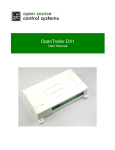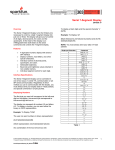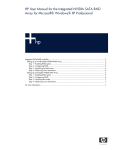Download PID Display Module User Manual
Transcript
PID Display Module User Manual Document Revision 1.0 October 1st, 2011 © 2011 Open Source Control Systems, Inc. All Rights Reserved. Product warranty or service will not be extended if: (1) the product is repaired, modified or altered, unless such repair, modification of alteration is authorized in writing by Open Source Control Systems, Inc. (“OSCSYS”); or (2) the serial number of the product is defaced or missing. OSCSYS PROVIDES THIS MANUAL “AS IS” WITHOUT WARRANTY OF ANY KIND AND MAKES NO OTHER REPRESENTATIONS OR WARRANTIES EITHER EXPRESS OR IMPLIED AS TO FITNESS FOR PURPOSE, MERCHANTABILITY OR OTHERWISE IN RESPECT OF THE PRODUCT. IN NO EVENT SHALL OSCSYS, ITS DIRECTORS, OFFICERS, EMPLOYEES OR AGENTS BE LIABLE FOR ANY DIRECT, INDIRECT, SPECIAL, INCIDENTAL, OR CONSEQUENTIAL DAMAGES (INCLUDING DAMAGES FOR LOSS OF PROFITS, LOSS OF BUSINESS, LOSS OF USE OR DATA, INTERRUPTION OF BUSINESS AND THE LIKE) WHETHER SUCH DAMAGES ARE INCURRED BY THE PERSON TO WHOM THIS WARRANTY EXTENDS OR A THIRD PARTY, EVEN IF OSCSYS HAS BEEN ADVISED OF THE POSSIBILITY OF SUCH DAMAGES ARISING FROM ANY DEFECT OR ERROR IN THIS MANUAL OR PRODUCT. SPECIFICATIONS AND INFORMATION CONTAINED IN THIS MANUAL ARE FURNISHED FOR INFORMATIONAL USE ONLY, AND ARE SUBJECT TO CHANGE AT ANY TIME WITHOUT NOTICE, AND SHOULD NOT BE CONSTRUED AS A COMMITMENT BY OSCSYS. OSCSYS ASSUMES NO RESPONSIBILITY OR LIABILITY FOR ANY ERRORS OR INACCURACIES THAT MAY APPEAR IN THIS MANUAL, INCLUDING THE PRODUCTS AND SOFTWARE DESCRIBED IN IT. Products and corporate names appearing in this manual may or may not be registered trademarks or copyrights of their respective companies, and are used only for identification or explanation and to the owners’ benefit, without intent to infringe. Contents 1 2 3 4 Overview............................................................................................................................................ 4 1.1 Safety Information...................................................................................................................... 4 1.2 PID Display Module Features .................................................................................................... 4 1.3 Package Contents ....................................................................................................................... 4 1.4 Before You Proceed .................................................................................................................... 4 Quick Start Guide .............................................................................................................................. 5 2.1 Connecting Power ...................................................................................................................... 5 2.2 Connecting the I2C bus .............................................................................................................. 5 2.3 Debug LED Status ...................................................................................................................... 6 2.4 Setting Module Address ............................................................................................................. 6 I2C PID Module Layout .................................................................................................................... 7 3.1 Layout ......................................................................................................................................... 7 3.2 LED Indicators ........................................................................................................................... 8 3.3 Buttons........................................................................................................................................ 8 3.4 Jumpers ....................................................................................................................................... 8 3.5 Connections ................................................................................................................................ 8 Mechanical Specifications ............................................................................................................... 10 4.1 Board Dimensions .................................................................................................................... 10 5 Electrical and Environmental Specifications ................................................................................... 10 6 Appendix A – Warranty ....................................................................................................................11 1 Overview The PID Display Module was designed to add PID Controller like displays to control systems like the BrewTroller and the BCS brewing control systems. The display is typically used to show current and target temperatures for a specific device in large, easy to read digits. The PID Display Module connects as an I2C or RS-485 slave display device to a control system and provides no direct monitoring or control of sensors and output devices. 1.1 Safety Information The PID Display Module is intended to be integrated into a brewing system by the purchaser. It is solely the purchaser's responsibility to assure that the system is configured in a manner consistent with applicable safety requirements. Open Source Control Systems, Inc. does not control how this board is integrated into the purchaser's system and cannot be responsible for guaranteeing the safety of your system. The PID Display Module connects to control systems that typically control devices that use dangerous voltages. Care must be taken that user cannot come in contact with these voltages. An enclosure that allows for modest ventilation, but prevents intrusion by operator’s hands and foreign objects should be utilized with this board. 1.2 PID Display Module Features • Atmel ATMEGA168 8 Bit Processor with 16kb Flash • I2C Communications Interface • RS485 Communications Interface (Requires free firmware update; Expected availability 12/2011) 1.3 Package Contents • PID Display Module 1.4 Before You Proceed Please review all safety and connection information before attempting to connect and power on your PID Display Module. Open Source Control Systems, Inc. is not responsible for damage caused to boards by improper connections. If you have any questions please do not hesitate to contact support. You can find phone numbers and contact forms on our website (http://www.oscsys.com). 2 Quick Start Guide 2.1 Connecting Power When using 3 or less units on a chain the I2C PID Display can be powered via the BrewTroller I2C expansion port. If using the PID Display with other controllers or if you are using more than 3 units then power will need to be provided via the X2 power connector to the first device on the chain. Then the rest of the devices will be powered with the bus. 2.2 Connecting the I2C bus A single locking connector provides power and I2C connectivity to each PID Display Module: I2C Connection on BrewTroller 4.0 I2C Connection on PID Display Module I2C Connection on I2CLCD Module 2.3 Debug LED Status The Debug LED serves as an indicator of board status. When flashing it means the board is running properly but not receiving any data. A solid Debug LED indicates the board is running and receiving data. If you have applied power and the debug light does not flash or go solid then check power connections and try again. If the board still does not respond contact OSCSYS Technical Support. 2.4 Setting Module Address If you are using more than one PID Display Module in your system or you want to change the target address follow the steps below. 1. Press and hold the button labeled SET ADDRESS on the back of the board. 2. The display will show ADDR and will flash the current address of the board for 5 seconds. Release the button if you do not want to change the address. 3. Continue to hold the button and the address will begin to go up, about one per second. When the address reaches your desired address just release the button. Addresses are in hexadecimal so keep that in mind when you see addresses like 2a and 3c. Generally you should use addresses starting at 20 – 2x for however many displays you have. 4. The display will flash SAVE ADDR for a few seconds and the new address is saved. The changes take effect immediately. 3 PID Display Module Layout 3.1 Layout 3 4 5 6 7 2 1 1. 2. 3. 4. 5. 6. 7. 8. I2C Input/Output Connectors AUX Power Input Connector Debug LED Power LED In Circuit System Programmer (ICSP) RS485 Termination Enable RS485 Connector Address Set Button 8 3.2 LED Indicators 3.2.1 Power Indicates power is connected to board. 3.2.2 Debug When this LED is flashing the board is operating normally but not receiving data from the host controller, if solid means data is being received. 3.3 Buttons 3.3.1 Set Address This button is used to set the listening address of the device. Press and hold to cycle through the addresses. 3.4 Jumpers 3.4.1 RS485 Termination If this device is the last in the RS485 chain then a jumper needs to be installed here. 3.5 Connections 3.5.1 3.5.2 X2 – Aux Power 1. 2. GND 12VDC 1. 2. 3. 4. 5. SDA SCL N/C 12VDC GND I2C Communications Port 3.5.3 3.5.4 ICSP Header 1. 2. 3. 4. 5. 6. MISO 5VDC SCK MOSI RESET GND 1. 2. 3. REF A B RS485 Connector 4 Mechanical Specifications 4.1 Board Dimensions 5 Electrical and Environmental Specifications Main Power Input 12VDC Logic-Level Communication 5VDC Ports Temperature 0° to +55° C Relative Humidity 20% to 80% relative humidity, non-condensing 6 Appendix A – Warranty Open Source Control Systems, Inc. (OSCSYS) warrants that this hardware product is in good working condition, according to its specifications at the time of shipment, for a period of 90 days from the date it was shipped from OSCSYS. Should the product, in OSCSYS's opinion, malfunction within the warranty period, OSCSYS will repair or replace the product without charge. Any replaced parts become the property of OSCSYS. This warranty does not apply to the software component of a product or to a product which has been damaged due to accident, misuse, abuse, improper installation, usage not in accordance with product specifications and instructions, natural or personal disaster or unauthorized alterations, repairs or modifications. All warranties for this product, expressed or implied, are limited to 90 days from the date of purchase and no warranties, expressed or implied, will apply after that period. All warranties for this product, expressed or implied, shall extend only to the original purchaser. The liability of Open Source Control Systems, Inc. in respect of any defective product will be limited to the repair or replacement of such product. Open Source Control Systems, Inc. may use new or equivalent to new replacement parts. Open Source Control Systems, Inc. makes no other representations or warranties as to fitness for purpose, merchantability or otherwise in respect of the product. No other representations, warranties or conditions, shall be implied by statute or otherwise. In no event shall Open Source Control Systems, Inc. be responsible or liable for any damages arising (a) (b) from the use of the product; from the loss of use of the product; (c) from the loss of revenue or profit resulting from the use of the product; or (d) as a result of any event, circumstance, action or abuse beyond the control of Open Source Control Systems, Inc. whether such damages be direct, indirect, consequential, special or otherwise and whether such damages are incurred by the person to whom this warranty extends or a third party.



















